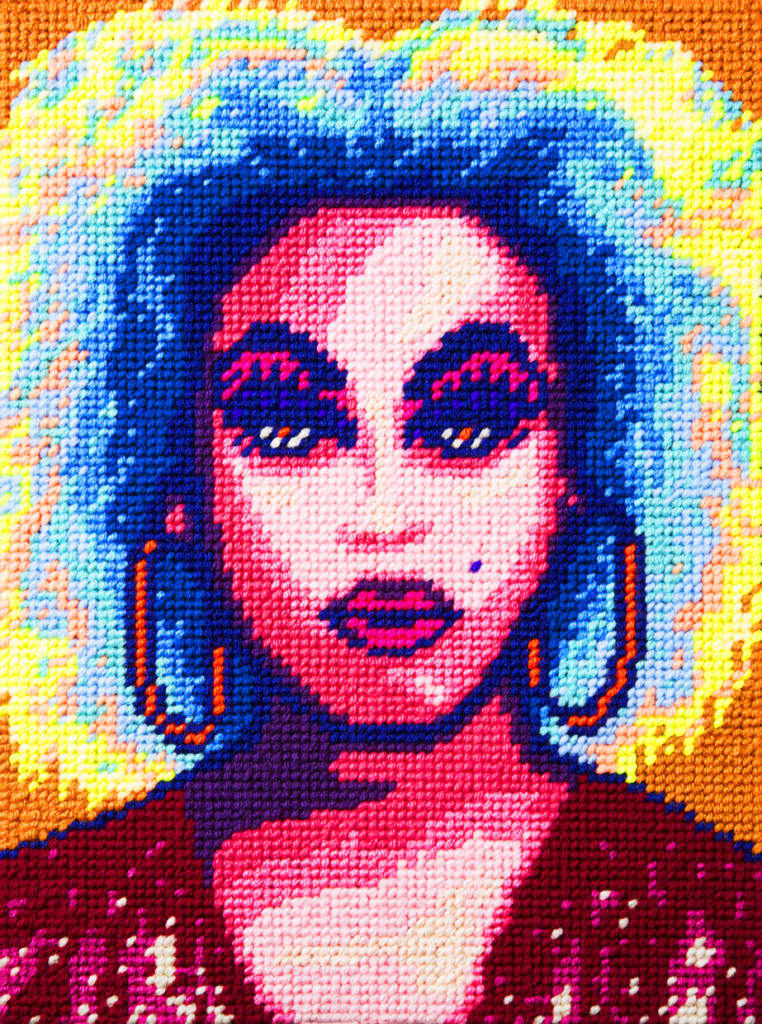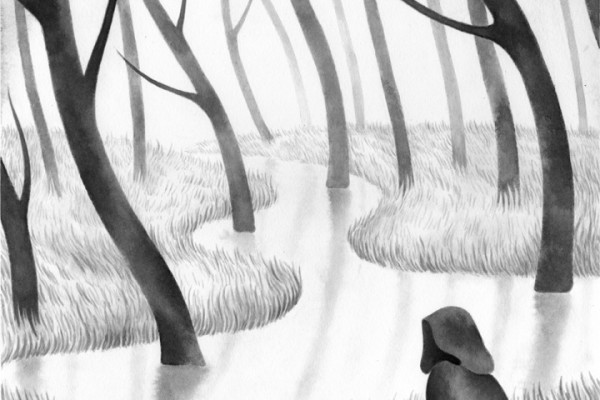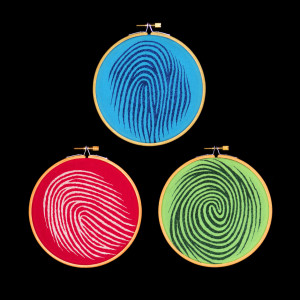 It’s probably been a minute since anyone has described cross-stitching as provocative. But one look at Aubrey Longley-Cook‘s handiwork will leave you flabbergasted prompted to turn your perception of this bygone art form on its head. While the medium traditionally conjures images of Quakers huddled around an oil lamp in a drafty cottage, Longley-Cook’s pieces are identifiable by their neon colors, complex textures and patterns, contemporary, edgy subject matter and digital symbiosis. Hailing from New England, Longley-Cook’s fascination with the arts began at an early age, when his mother would quiz him and his brother on postcard-sized replicas of famous works she assembled on their refrigerator. Longley-Cook learned to admire craftsmanship and creativity from her, and after studying animation at the Rhode Island School of Design, the artist moved to Atlanta in 2007. Drawn to the local art scene, low cost of living, reputable food and open queer community, he quickly made a name for himself in this Southern metropolis. His work had been featured on the cover of Atlanta magazine and in exhibitions from the Goat Farm to the Leslie Lohman Museum in NYC.
It’s probably been a minute since anyone has described cross-stitching as provocative. But one look at Aubrey Longley-Cook‘s handiwork will leave you flabbergasted prompted to turn your perception of this bygone art form on its head. While the medium traditionally conjures images of Quakers huddled around an oil lamp in a drafty cottage, Longley-Cook’s pieces are identifiable by their neon colors, complex textures and patterns, contemporary, edgy subject matter and digital symbiosis. Hailing from New England, Longley-Cook’s fascination with the arts began at an early age, when his mother would quiz him and his brother on postcard-sized replicas of famous works she assembled on their refrigerator. Longley-Cook learned to admire craftsmanship and creativity from her, and after studying animation at the Rhode Island School of Design, the artist moved to Atlanta in 2007. Drawn to the local art scene, low cost of living, reputable food and open queer community, he quickly made a name for himself in this Southern metropolis. His work had been featured on the cover of Atlanta magazine and in exhibitions from the Goat Farm to the Leslie Lohman Museum in NYC.
CommonCreativ: How did you become interested in textile arts?
Aubrey Longley-Cook: I created hand-drawn, painted and puppet animations while in school. I began to explore embroidery during my sophomore year as a way to unwind after coming home from studio. The tactility of the process was intimate and personal, and the hand-made nature was grounding and calming. While my two passions remained relatively separate during school, I found similarities and connections between the two repeated processes. I’ve had a lot of great teachers and mentors growing up, and their support and guidance helped me find the confidence to pursue a career in the arts.
CC: Other than cross-stitch and needlepoint, are there any other techniques that you use on a regular basis?
ALC: I mainly use satin stitch and cross-stitch. I started working in needlepoint this last year, and I like how fast that process can be. I’ll use a sewing machine to create larger installation work.
CC: What process do you use to create your pieces?
ALC: Picking my color palette usually happens early in my process. If my design includes text or is complicated, I’ll prepare a template to work off of. A guide is also necessary, with an animated embroidered sequence for registration purposes. If I’m making abstract work, I’ll usually stitch without a template and build the design off of a structured pattern or set of predetermined steps.
CC: Do you ever work in other media?
ALC: I enjoy combining embroidery and animation. The work creates a compelling contrast between the physical and the digital. The repetition of the animated motion is mirrored in the process of the hand work required for the creation of multiple embroideries for an animated series. Themes of repetition also have an important link to gender theory’s position that the normative is not essentially natural, but rather a matter of repeated cultural performance that can be interrupted and performed differently.
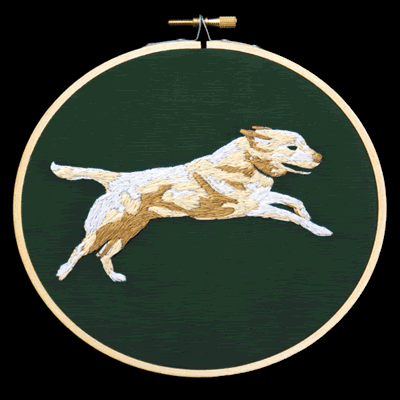 I’ve been working at a larger scale recently, and it was exciting to be commissioned to create a photo booth environment for WonderFarm last month. I installed an 18’ x 10’ chain link fence in the space, and it was interesting working [with] a larger grid. It’s helpful for me to experiment with different scales and materials. Experiments can lead to unexpected places, and it helps keep the process fresh.
I’ve been working at a larger scale recently, and it was exciting to be commissioned to create a photo booth environment for WonderFarm last month. I installed an 18’ x 10’ chain link fence in the space, and it was interesting working [with] a larger grid. It’s helpful for me to experiment with different scales and materials. Experiments can lead to unexpected places, and it helps keep the process fresh.
CC: Do you feel like there’s a message or theme that unifies the various projects that you’ve been working on? Is there a piece of yours that has significant importance to you?
ALC: I’m inspired by queer community, GIF culture and work that combines domestic practices with new media. I’m interested in the narrative of loops and the investigation of repetition in reference to memory. My embroideries often play with queer identity and gender roles, and I like that there’s an undercurrent of those themes inherent to male fiber work.
I’ve documented members of my queer family through needlepoint portraiture and embroidered animated sequences. By stitching the faces of Atlanta’s fledgling drag queens, I’m able to elevate the individual performers while documenting the greater threads that connect our community. As a gay man, I’ve had to adjust the expectations for my life’s course and rework my understanding of what it means to be family. My work documents this reconstruction and, by displaying these portraits as infinitely-looping narratives, the queens’ identities and the alternate structures of family we have established are chronicled.
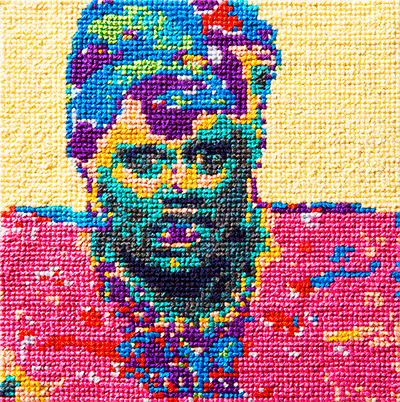 Through leading the RuPaul Cross Stitch Animation Workshop [late last year], I was able to engage public participants in my usually private process. The utilization of Atlanta’s eager artistic community permitted an expansion in both the scope of my work, be it the consideration of time and technique, and the possibility for further abstraction from the original conception. During the workshop, 35 participants learned to cross-stitch, viewed experimental animations, and were treated to performances by local queens. Each was assigned an individual template based on stills from two seconds of RuPaul’s “Supermodel” music video. While the original footage is black and white, each stitcher chose a color palette that corresponded tonally to the lights and darks of the original footage. This allowed the clip to be abstracted from its original articulation by animating in a kaleidoscope of color, using every crayon in the box, as RuPaul always reminds.
Through leading the RuPaul Cross Stitch Animation Workshop [late last year], I was able to engage public participants in my usually private process. The utilization of Atlanta’s eager artistic community permitted an expansion in both the scope of my work, be it the consideration of time and technique, and the possibility for further abstraction from the original conception. During the workshop, 35 participants learned to cross-stitch, viewed experimental animations, and were treated to performances by local queens. Each was assigned an individual template based on stills from two seconds of RuPaul’s “Supermodel” music video. While the original footage is black and white, each stitcher chose a color palette that corresponded tonally to the lights and darks of the original footage. This allowed the clip to be abstracted from its original articulation by animating in a kaleidoscope of color, using every crayon in the box, as RuPaul always reminds.
CC: How has the Atlanta arts scene been supportive of your work?
ALC: Some of the first few times that I showed work in Atlanta were at the Mondo Homo Festivals. Kathy King and Donnie Reider did a great job curating the annual art shows, and I met a lot of the city’s queer community through my participation. It was a huge honor receiving an Emerging Artist Award from Atlanta’s Office of Cultural Affairs earlier this year. Also being a member of WonderRoot’s 2013/14 Walthall Artist Fellowship has been enlightening and galvanizing. The program has been a space for growth, and the insight from my mentor Joey Orr has been invaluable. Barbara Archer Gallery and Erikson Clock provided infinite support for my solo show “Serving Face” last year, and I’m forever thankful for the thousands of hours of communal stitching done by the members of my RuPaul Cross Stitch Animation Workshop.
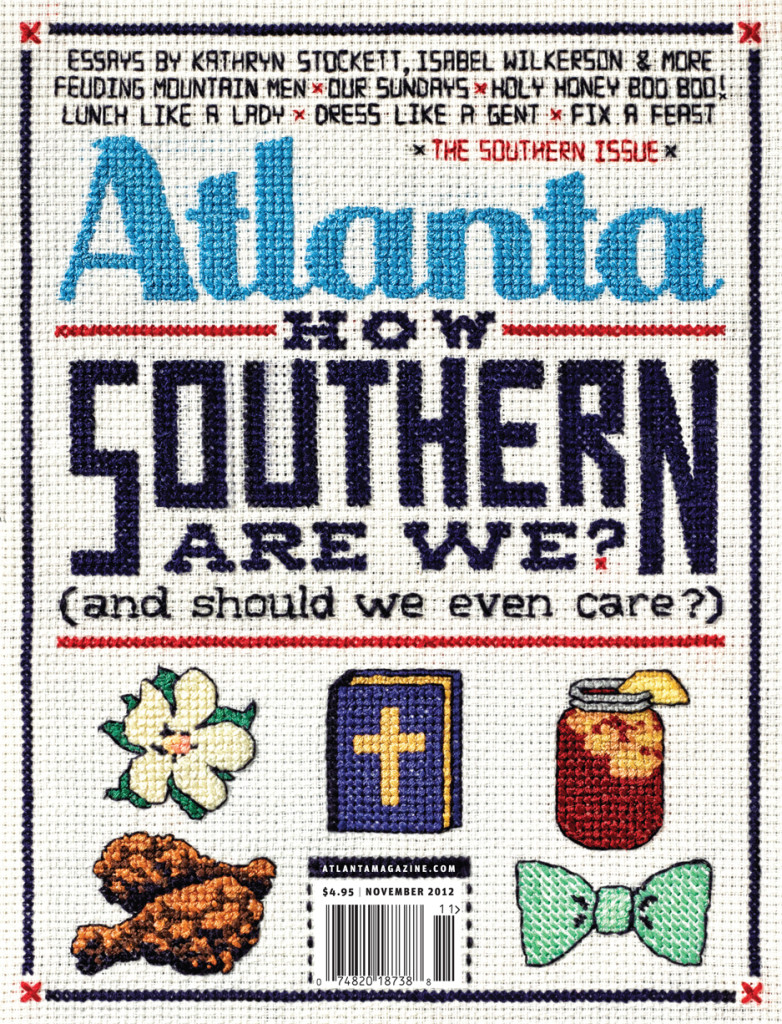 CC: Is there anyone in town (or out of town) that you’d like to collaborate on a piece with?
CC: Is there anyone in town (or out of town) that you’d like to collaborate on a piece with?
ALC: I’d love to pixel battle with Ashley Anderson, make monsters with Mike Stasny, assume alternate identities with Antonio Darden, get swampy with Jared Dawson, write a play with Johnny Drago, paint a mural with Heather Greenway, make a video with Clovice Holt, and cross-stitch massive patterns with Paul Bazen. My dream collaboration would be to stitch with Argentinian embroidery masters Chiachio & Giannone.
CC: What are you working on now, and what do you hope to accomplish in the future with your work?
ALC: I’ll be screening animated work at Ponce City Market for “45 Seconds or Less” on June 12th from 7 to 9pm. I’m creating a fabric installation for Meh Meh, a dance performance at the Druid Hills Baptist Church featuring Erik Thurmond and Nicholas Goodly, with a light installation by Kevin Byrd and sound by Ben Coleman. The performance will run June 12th-14th from 9 to 10pm. I’m also building work for the upcoming WonderRoot Walthall Artist Fellowship exhibits that will be held at Gallery 72 in August and September. The duel shows will be the culmination of this last year’s program, and I’m excited to display work with my fellows. I hope to run another community-based craft and animation workshop in the future. I would use a different technique like latch hook, needlepoint or French knots.
CC: What do you hope the audience takes away from seeing or interacting with your artwork?
ALC: The itch to stitch.
You can see more of Aubrey Longley-Cook’s work in his portfolio.

